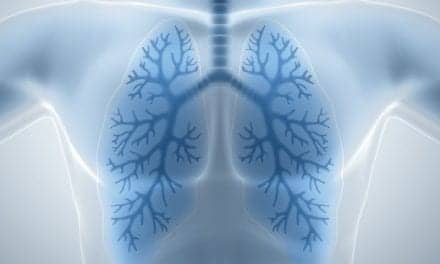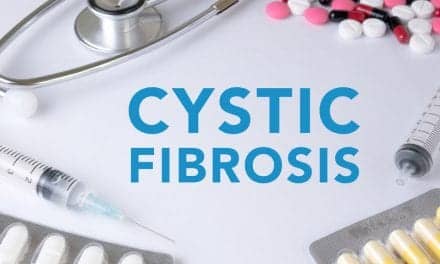Clinicians share best practices for implementing CFTR modulators in some of their youngest cystic fibrosis patients, while research explores their potential to lessen the burden of care.
By Alyx Arnett
The US FDA recently expanded the indications of two cystic fibrosis transmembrane conductance regulator (CFTR) drugs to encompass younger patients with specific CF mutations, giving more children access to highly effective modulator therapies.
CF is caused by mutations in the CFTR gene, resulting in a dysfunctional CFTR protein. CFTR modulators target specific defects in the CFTR protein so that the protein can work properly.1 The drugs have shown promise in preventing numerous CF-related complications, potentially reducing the long-term dependence on airway clearance therapies—which can be particularly challenging for pediatric patients.
The FDA approved Trikafta (elexacaftor/tezacaftor/ivacaftor) in April for children aged 2 to 5 who have at least one copy of the F508del mutation—the most common mutation—or certain mutations that have demonstrated responsiveness to Trikafta based on laboratory data. The approval expanded the eligible pool of patients to approximately 2,250 children, including 900 who were eligible for a CFTR modulator for the first time.
While impacting fewer patients, the FDA approved Kalydeco (ivacaftor) in May for use in children aged 1 to 4 months who have at least one mutation in their CFTR gene that is responsive to Kalydeco based on clinical and/or in vitro assay data.
“They’re not a cure of the disease because the body’s still making this protein abnormally, but there have been some really grand-slam, home run results from these drugs,” said Don B. Sanders, MD, MS, director of the pediatric cystic fibrosis center at Riley Hospital for Children and IU Health.
CFTR Modulators for the Youngest CF Patients
Since the FDA approved ivacaftor in patients down to 4 months of age in September 2020, Rebekah Brown, MD, associate professor of pediatrics in the division of allergy, immunology, and pulmonary medicine and director of the cystic fibrosis center at Vanderbilt University Medical Center, said there have been significant improvements in patients in the lack of progression of their disease.
The latest approval opens the medication up to patients even younger. In a phase 3 study in CF patients younger than 2 years old, which included a cohort of patients aged 1 to 4 months, Kayldeco demonstrated a favorable safety profile and absolute change from baseline in sweat chloride concentration—a measure of CFTR function—at week 24.
“So, for the first time, we’re really diagnosing kids in the first few weeks of life and then starting a daily oral medication that we think can really prevent a lot of the complications of CF,” said Sanders, who’s also an associate professor of pediatrics at IU School of Medicine.
The approval of elexacaftor/tezacaftor/ivacaftor down to age 2 could yield an even more substantial impact, given that approximately 90% of CF patients possess the mutation that makes them eligible for this medication, a much broader patient base than ivacaftor (around 5-10%). In a phase 3 study involving children aged 2-5, Trikafta demonstrated favorable tolerability while reducing sweat chloride concentration and improving lung function. Additionally, patients maintained a stable body mass index over the 24-week treatment period.
“We’re very optimistic…that [these drugs] will hopefully slow down the progression of the disease process, and ultimately patients may not have as much lung disease at a young age and may not require the intense burden of care,” said Brown.
Sanders and Brown recommend initiating patients on a CFTR modulator as soon as they become eligible. Still, some parents have been hesitant to start their young children on medication as they may appear healthy and have not yet experienced severe complications. Working with families to allay concerns is key, including informing families about monitoring protocols for side effects. Sanders’ patients routinely undergo liver function tests to monitor any changes, are recommended annual eye exams to look for early cataracts, and are seen frequently to ensure they’re benefiting from the drugs.
“Even though over the last 30 years outcomes for people with CF have really improved, it’s still a lot of work. There’s a lot of still risk of hospitalizations and risk of lung damage that maybe you’re not going to recover from, so my opinion is I would like almost everybody to be on it,” he said.
As Brown considers starting her pediatric patients on CFTR modulators, she examines their lab work, alongside any behavioral and mental health issues that might necessitate considering a modified dose or adjusting monitoring protocols.
“What we found is that being upfront about potential side effects, providing the information upfront about the medications, and addressing those concerns and talking through how we monitor for side effects has been really helpful in the family buy-in to the medication and has also allowed for more conversations when side effects do arise,” said Brown, adding that “the benefits far outweigh any of the side effects that we see.”
Could CFTR Modulators Lessen the Burden of CF Care?
As CFTR modulators become available to more patients, it raises the question of whether patients can decrease or discontinue other medications or airway clearance therapies, thereby alleviating the burden of care.
A recent study examined whether people with CF aged 12 and older on Trikafta experienced a change in lung function when they discontinued either hypertonic saline or dornase alfa, commonly prescribed mucus thinners. The six-week study found that participants with “relatively well-preserved pulmonary function” could stop taking one of the two medications without adversely affecting their health.2
Some individuals with lower lung function—a forced expiratory volume of less than 70%—experienced more frequent adverse events, such as coughing and increased sputum.
Additional studies, including HERO-2 and CF-STORM, are evaluating longer-term health effects to provide further insight into the implications of discontinuing medications and therapies while taking Trikafta.
According to Sanders, airway clearance emerged as a top response among surveyed CF patients when asked about their preferences for studies investigating which treatment modalities could potentially be stopped while using a CFTR modulator. Such studies, Sanders said, would help understand the risks and benefits of discontinuing certain airway clearance therapies in healthy patients.
Traditional Airway Clearance Still Key
The Cystic Fibrosis Foundation recommends daily airway clearance for CF patients aged 2-5,3 and, on average, CF patients must dedicate over 100 minutes each day to airway clearance to prevent infections and inflammation in their lungs.4 For children, adherence to airway clearance therapy can be challenging; adherence has been reported to be less than 50%, and the difficulty in consistently maintaining daily care has been linked to poor health outcomes.5
With CFTR modulators now more widely available to young patients, there’s a chance such intensive airway clearance requirements could eventually change. But until there’s quality data indicating such, Sanders said traditional airway clearance therapies will remain a part of his regimen.
Almost all his patients, starting around age 2, use a vest for high-frequency chest wall oscillation. Sanders typically recommends patients use the vest for 30 minutes twice a day with multiple frequencies when they’re healthy. “The key for me is, at the first sign of a new cold or new respiratory symptom, to increase to three or four times a day,” he said.
According to Brown, advances in vest therapy over the last several years have provided patients with increased freedom and caregivers and providers with valuable compliance data.
Portable, battery-operated vests now allow some patients to use the therapy on the go, while the introduction of electronic usage tracking options enables healthcare providers and parents, if given access, to monitor therapy adherence more efficiently.
Brown reassesses her patients using vest therapy annually to ensure they’re on the most appropriate settings. “We want to make sure that our teenagers aren’t still on the same settings as they were when they were 5. The settings should change to meet their needs,” she said.
As oscillating positive expiratory pressure (PEP) therapy can be more challenging in younger patients since it’s more technique-dependent, requiring patients to blow out many times through a device to vibrate the airways to dislodge mucus, Brown doesn’t typically recommend it until patients are older, around ages 10 to 12. Sanders oftentimes recommends the Acapella PEP device as a backup to vest therapy or to patients who are traveling. “There are some kids who want to be really interactive with their airway clearance and can be very motivated to give a really good effort to get the most out of PEP. In those kids, it makes sense and in the kids who don’t want to be stuck sitting still for a half hour twice a day while they do their vest treatments.”
According to Brown, having multiple airway clearance options can be key. “We find that, especially in the older children, having a few different airway clearance modalities to provide them with flexibility improves their adherence to the therapies because, ultimately, the most effective airway clearance is going to be the one you do,” she said.
Ongoing Research into Genetic Therapies
As approximately 7% of CF patients still do not qualify for a CFTR modulator, A. Whitney Brown, MD, senior director of clinical affairs at the Cystic Fibrosis Foundation, is hopeful the next wave of clinical trials focused on genetic-based therapies will ensure all CF patients “have a transformative therapy in their future.”
Since the discovery of the CFTR gene in 1989, scientists have been working to develop an effective gene therapy. However, out of 36 CF gene therapy clinical trials involving around 600 patients conducted so far, desired outcomes have yet to be achieved.6 Research is ongoing as scientists continue to work to find a way to correct mutations in the CFTR gene (known as integrating therapy) or provide a correct copy of the CFTR gene to cells (known as non-integrating therapy).
Four genetic therapies are currently in phase 1 clinical trials, and eight are in pre-clinical trials. One clinical trial in the US is studying the safety and tolerability of an investigational non-integrating gene therapy in adults with CF who are ineligible for or unable to tolerate CFTR modulator therapy. A clinical trial exploring the safety of integrating gene therapy could happen in the next few years.7
“When we discovered this CFTR gene in 1989, we thought it would be really easy to do genetic therapy, and here we are how many years later?” said Sanders. “But I think there have been advances in the science that have overcome some limitations that we are starting to get closer.”
He emphasizes that developing a drug that isn’t dependent on a patient’s mutation would ensure some patients aren’t left behind. While acknowledging the success of current CFTR modulators, Sanders said, “There’s work to do to get them to everybody and make sure they’re as safe as possible.”
Brown agreed, adding, “I am hopeful that as we move forward with CF research that we will be able to have a medication that will work for 100% of our patients.”
RT
Alyx Arnett is associate editor of RT. For more information, contact [email protected].
References
- CFTR Modulator Therapies. Cystic Fibrosis Foundation. Available at https://www.cff.org/managing-cf/cftr-modulator-therapies
- Mayer-Hamblett N, Ratjen F, Russell R, et al. Discontinuation versus continuation of hypertonic saline or dornase alfa in modulator treated people with cystic fibrosis (SIMPLIFY): results from two parallel, multicentre, open-label, randomised, controlled, non-inferiority trials. Lancet Respir Med. 2023;11(4):329-40.
- Lahiri T, Hempstead SE, Brady C, et al. Clinical practice guidelines from the Cystic Fibrosis Foundation for preschoolers with cystic fibrosis. Pediatrics. 2016;137(4):e20151784.
- Chaudary N, Balasa G. Airway clearance therapy in cystic fibrosis patients insights from a clinician providing cystic fibrosis care. Int J Gen Med. 2021 Jun 14;14:2513-21.
- Byrwa DJ, Perez GF, Roach CM, Prentice S, Goetz DM. Airway clearance therapy in the school environment: Retrospective analysis of a cohort of pediatric patients with cystic fibrosis. J Cyst Fibros. 2023 Jan 24;S1569-1993(23)00007-3.
- Sui H, Xu X, Su Y, et al. Gene therapy for cystic fibrosis: Challenges and prospects. Front Pharmacol. 2022 Oct 11;13:1015926.
- Research into Genetic Therapies. Cystic Fibrosis Foundation. Available at https://www.cff.org/research-clinical-trials/research-genetic-therapies










